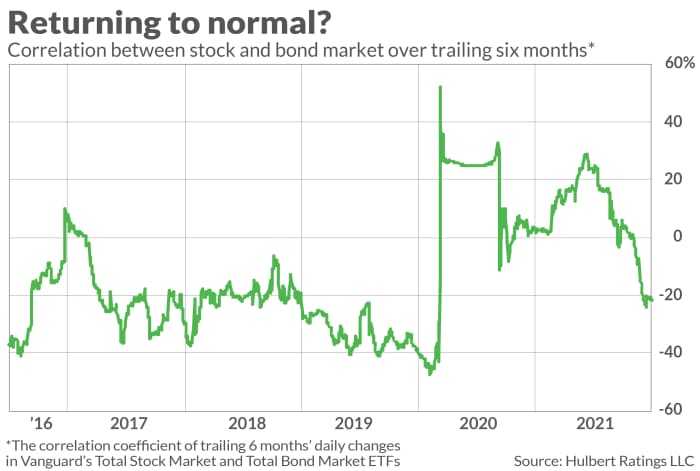It’s good news that bonds went down last year.
I doubt that’s how you reacted when reviewing the 2021 performance scoreboards, of course. The total U.S. domestic bond market lost 1.9% last year, as judged by the Vanguard Total Bond Market ETF BND, -0.22%. Long-term Treasurys lost even more, losing 5.0% (as judged by the Vanguard Long-Term Treasury ETF VGLT, -0.67% ). You might think it’s difficult to put lipstick on this pig.
The reason I think we should try: Bonds are a diversifier for your retirement portfolio—reducing the volatility-based risk otherwise associated with an all-stock portfolio. But being a diversifier means they should zag when stocks zig, and vice versa. And that’s exactly what they did last year.
Those who nevertheless were disappointed by bonds’ performance last year want to have their cake and eat it to. But that’s magical thinking: You can’t expect bonds both to be a diversifier in your portfolio and that they should rise when stocks rise. Given that the stock market performed so spectacularly last year—up 25.7%, as judged by the Vanguard Total Stock Market ETF VTI, -0.37% —it therefore should not come as a big surprise that bonds struggled.
There’s another way in which bonds’ struggle last year is good news: It counters a narrative that emerged early in the pandemic that there had been a more or less permanent increase in the stock-bond correlation. According to that narrative, interest rates had become so low that they had nowhere to go but up. If so, then investors would be kidding themselves in hoping that bonds would cushion any stock market decline.
In light of what happened last year, it now appears that the positive stock-bond correlation in early 2020 was a temporary phenomenon. This is illustrated in the accompanying chart, which plots the trailing six months’ correlation between the total stock and total bond markets. Notice that, though this correlation shot way up to very high levels early in 2020, it since then has declined back to prior levels.

Hope for the 60:40 portfolio
The return of the negative stock-bond correlation suggests it would be premature to throw in the towel on the 60% stock/40% bond portfolio—perhaps the most popular asset allocation used by retirees.
You might still have some reservations, given that interest rates—even though not as low as they were in the early stages of the pandemic—remain very low by historical standards. But research conducted by the Portfolio Solutions Group, a part of AQR Capital Management, finds that low rates are not—in and of themselves—a reason to give up on the hope and belief that bonds can be a good diversifier.
The study, which I first wrote about last May, urges us to focus instead on how far interest rates could fall in any given 12-month period. Only if you think rates can’t fall very much—50 basis points or less—should you question bonds’ potential to be a good diversifier. So long as you believe it possible that rates could fall by at least 100 basis points, then bonds retain close to their full diversification potential.
This precondition is met currently. In the last 18 months rates have been well more than 100 basis points lower than where they are today. In fact, the 10-year Treasury yield currently stands at 1.76%, 125 basis points higher than where it stood in the summer of 2020.
Mark Hulbert is a regular contributor to MarketWatch. His Hulbert Ratings tracks investment newsletters that pay a flat fee to be audited. He can be reached at mark@hulbertratings.com.
